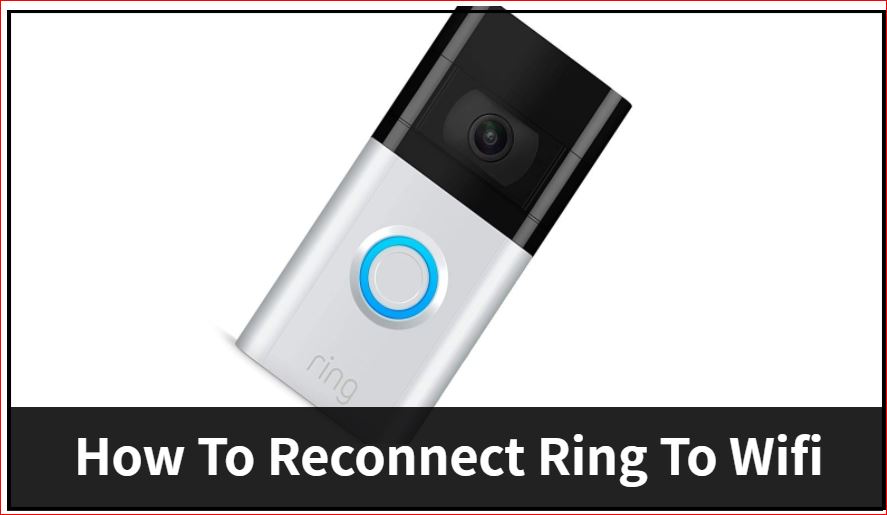Maintaining a seamless connection to your smart home devices is essential. We will explore how to reconnect Ring Doorbell to WiFi to ensure a seamless secure home or office since we know that your Ring Doorbell is no exception.
Whether you’ve recently changed your WiFi network thus requiring a transpiration on Ring Doorbell or encountered connectivity issues, knowing how to reconnect your Ring Doorbell to WiFi is a valuable skill. You may moreover want to move the connection to the WiFi extender for your Ring Doorbell WiFi connection. In this article, we’ll guide you through the step-by-step process to ensure your Ring Doorbell is when online and alimony your home secure.
From opening the Ring app to confirming a successful reconnection, we’ve got you covered with easy-to-follow instructions that will have your device up and running in no time. So, let’s swoop in and ensure your Ring Doorbell remains a reliable guardian of your home.
How to reconnect Ring Doorbell to WiFi
Reconnecting your Ring Doorbell to WiFi is a straightforward process that can be washed-up using the Ring app. These steps are workable to various Ring Doorbell models, including the Ring Video Doorbell, Ring Video Doorbell 2, Ring Video Doorbell 3, Ring Video Doorbell Pro, Ring Video Doorbell Elite, and Ring Peephole Cam. Here’s a detailed guide on how to do it:
- Open the Ring App: Start by launching the Ring app on your smartphone or tablet. Make sure you are logged in with the same worth that your Ring Doorbell is associated with.
- Access the Menu: In the Ring app, squint for the menu icon, which is represented by three horizontal lines (≡) in the top-left or top-right corner of the screen. Tap on this icon to wangle the menu.
- Navigate to Devices: Within the menu, you will find various options. Squint for “Devices” and tap on it. This will take you to a list of all your Ring devices.
- Select Your Doorbell: From the list of devices, segregate the Ring Doorbell or camera that you want to reconnect to WiFi. Tap on its name to wangle its settings.
- Access Device Health: Inside the device settings, you should see an option tabbed “Device Health.” Tap on this option to wangle the device’s health status and network settings.
- Change Network: Under the Device Health section, you will find an option to “Change Network.” Tap on this option to uncork the process of reconnecting your Ring Doorbell to a new WiFi network or re-establishing the connection to the existing network.
- Follow the Prompts: The Ring app will guide you through the process of connecting your Ring Doorbell to WiFi. This typically involves selecting your new WiFi network, inward the WiFi password, and pursuit any spare prompts provided by the app.
- Wait for Reconnection: After you’ve provided the necessary information and confirmed the settings, requite your Ring Doorbell some time to establish a connection with the new or existing WiFi network. This may take a few moments.
- Check Signal Strength: Once the reconnection process is complete, it’s essential to ensure that your Ring Doorbell has successfully reconnected to the network. You can do this by going when to the Device Health section and checking the WiFi signal strength. A strong signal indicates a successful reconnection.
- Test the Doorbell: To be unrepealable that everything is working correctly, test your Ring Doorbell by ringing it or triggering any motion sensors. Make sure you receive notifications and can wangle the live video feed through the Ring app.
For the Ring Camera, the steps are the same except if the camera is mounted upper on the wall. In that instance, you can use either the Movement or Setup Button to reconnect. If your Ring Doorbell or Ring camera is too upper to hands wangle the button, choosing Movement will reconnect your device to WiFi by using the camera’s Motion Detection.
How to reconnect Ring Doorbell to new WiFi
Reconnecting your Ring Doorbell to a new WiFi network is a crucial step when you transpiration your internet service provider or move to a new location. Here’s a detailed guide on how to reconnect your Ring Doorbell to a new WiFi network:
- Open the Ring App: Uncork by launching the Ring app on your smartphone or tablet. Ensure that you are logged in with the same Ring worth that your Ring Doorbell is associated with.
- Access the Menu: Squint for the menu icon in the top-left or top-right corner of the screen. It is represented by three horizontal lines (≡). Tap on this icon to unshut the menu.
- Navigate to Devices: Within the menu, you will find various options. Locate and tap on “Devices.” This will take you to a list of all your Ring devices.
- Select Your Doorbell: From the list of devices, segregate the Ring Doorbell that you want to reconnect to a new WiFi network. Tap on its name to wangle its settings.
- Access Device Health: Inside the device settings, you should see an option tabbed “Device Health.” Tap on this option to wangle the device’s health status and network settings.
- Change Network: Under the Device Health section, you will find an option to “Change Network.” Tap on this option to initiate the process of connecting your Ring Doorbell to the new WiFi network.
- Follow the Prompts: The Ring app will guide you through the process of connecting your Ring Doorbell to the new WiFi network. Typically, you will need to:
- Select the New WiFi Network: Segregate your new WiFi network from the list of misogynist networks. Make sure you select the correct network that you want to connect to.
- Enter WiFi Password: If prompted, enter the WiFi password for the new network. Ensure that you enter it correctly to stave any connection issues.
- Confirm Settings: Review the settings to ensure they are accurate. Double-check the network name (SSID) and password.
- Follow Spare Prompts: Depending on your specific Ring Doorbell model and app version, you may need to follow spare prompts. These could include scanning a QR lawmaking or pressing a sawed-off on the Ring Doorbell to personize the connection.
- Wait for Reconnection: After providing the necessary information and confirming the settings, requite your Ring Doorbell some time to establish a connection with the new WiFi network. This may take a few moments.
- Check Signal Strength: Once the reconnection process is complete, return to the Device Health section in the Ring app and trammels the WiFi signal strength. A strong signal indicates a successful reconnection to the new WiFi network.
- Test the Doorbell: To ensure that everything is working correctly, test your Ring Doorbell by ringing it or triggering any motion sensors. Make sure you receive notifications and can wangle the live video feed through the Ring app.
Causes of WiFi disconnections
WiFi disconnections can be frustrating, but understanding the possible causes can help you troubleshoot and resolve the issue effectively. Here are the worldwide causes of WiFi disconnections:
- Internet Service Disruption: Sometimes, the problem may not be with your WiFi network but with your internet service provider. There could be outages or disruptions in your zone due to maintenance or technical issues. Trammels if other devices are moreover experiencing internet connectivity problems.
- WiFi Network Changes: If your WiFi network name (SSID) or password has changed, your Ring device won’t be worldly-wise to connect. Ensure that you have the correct network name and password entered in your Ring app settings.
- Frequency Compatibility: Some Ring devices may not be uniform with 5 GHz WiFi networks. If you recently switched from a 2.4 GHz network to a 5 GHz network and your Ring device doesn’t support it, you’ll need to re-enable the 2.4 GHz network. All Ring doorbells and security cameras are uniform with 2.4 GHz networks.
- Physical Obstructions: Physical obstacles between your Ring device and your WiFi router can weaken the WiFi signal, leading to disconnections. Worldwide obstructions include large metal appliances, thick walls, heavy furniture, and dumbo towers materials like touchable or stone. Reposition your router or Ring device to reduce obstructions, or consider using WiFi extenders to modernize coverage.
- Power Issues: A sudden power outage or a squandered fuse can disrupt the operation of your Ring device and WiFi router. Ensure that both your Ring device and router have a stable power source. Some Ring devices have replacement power options, so trammels if they are functioning correctly.
- WiFi Interference: Other electronic devices operating on the same frequency as your WiFi network can rationalization interference and disconnections. This includes cordless phones, victual monitors, and plane neighboring WiFi networks. Try to minimize interference by waffly your WiFi waterworks or frequency band.
- Overloaded Network: If too many devices are unfluctuating to your WiFi network simultaneously, it can lead to congestion and disconnections. Consider upgrading your internet plan or limiting the number of unfluctuating devices, expressly during high-demand times.
- Router Issues: Problems with your WiFi router itself, such as outdated firmware or hardware issues, can rationalization connectivity problems. Ensure that your router is up to stage with the latest firmware and consider resetting it to factory settings if issues persist.
- Signal Strength: Weak WiFi signal strength can result in frequent disconnections. Use WiFi signal strength testing tools or apps to identify areas with poor coverage and consider subtracting WiFi extenders or wangle points to modernize coverage.
- Device Software/Firmware: Outdated firmware or software on your Ring device can lead to compatibility issues. Ensure that your Ring device is running the latest firmware, and update it if necessary.
Reconnecting Your Ring Doorbell to Wi-Fi Manually
You can manually reconnect your Ring Doorbell to Wi-Fi by accessing the “Change Wi-Fi Network” option in the Ring app, pressing the orange setup sawed-off on the when of the device, and pursuit the app’s prompts to link it to your home’s Wi-Fi network. Reconnecting your Ring Doorbell to WiFi manually can be necessary if you’re waffly your WiFi network or facing connectivity issues. Follow these step-by-step instructions:
- Remove the Doorbell from the Wall: If your Ring Doorbell is once installed on the wall, you’ll need to temporarily remove it from its mounting bracket. This step is essential for accessing the device’s setup button.
- Open the Ring App: On your smartphone or tablet, unshut the Ring app. Make sure you are logged in with the same worth that your Ring Doorbell is associated with.
- Access Device Health and Transpiration WiFi Network: a. Tap on the menu icon in the top-left or top-right corner of the Ring app. This icon is represented by three horizontal lines (≡). b. From the menu, select “Device Health.” c. Under the Device Health section, find and tap on the option labeled “Change Wi-Fi Network.” This will initiate the process of reconnecting your Ring Doorbell to WiFi.
- Press the Orange Sawed-off on Your Ring Doorbell: On the when of your Ring Doorbell, you should see an orange setup button. Press and hold this sawed-off for a few seconds until you see the light on the front of the device uncork to flash.
- Connect the Ring Using Your Phone: The Ring app will prompt you to connect to the Ring Doorbell’s temporary setup network. It will have a name similar to “Ring-Setup-XXXX.” Follow these steps: a. Unshut your phone’s Wi-Fi settings. b. Squint for and connect to the temporary Ring network. c. Return to the Ring app.
- Link Your Ring to Your Home’s WiFi: a. In the Ring app, follow the on-screen instructions to select your home’s WiFi network from the misogynist options. b. Enter the password for your WiFi network. c. Wait for the Ring Doorbell to establish a connection to your home’s WiFi. This may take a moment.
- Complete the Setup: Once your Ring Doorbell successfully connects to your home’s WiFi network, the Ring app will personize the setup is complete. You can now reinstall the Ring Doorbell on its mounting subclass if you removed it earlier.
- Test the Doorbell: To ensure that everything is working correctly, test your Ring Doorbell by ringing it or triggering any motion sensors. Make sure you receive notifications and can wangle the live video feed through the Ring app.
Reconnecting Ring to Wi-Fi Without QR Code
You can reconnect a Ring Doorbell to WiFi without a QR lawmaking by retrieving the setup PIN or lawmaking from the device’s packaging, installation guide, or the shower compartment. If you encounter difficulties, you can moreover contact Ring’s support team for assistance with the setup process. Reconnecting your Ring device to Wi-Fi without a QR lawmaking can be washed-up by pursuit these steps:
- Retrieve the Setup Code/PIN:
- Check the packaging box of your Ring device for any included setup codes or PINs.
- Consult the installation guide or user transmission that came with your device, as the lawmaking may be printed there.
- For unrepealable devices, the lawmaking might be located inside, on the side, or at the marrow of the shower compartment.
-
Contact Support (If Needed):
- If you are unable to locate the setup lawmaking by any of the whilom methods, consider reaching out to Ring’s consumer support team for assistance.
- Ring’s support team can guide you through the setup process and provide volitional methods to reconnect your device to Wi-Fi.
What is the Wi-Fi Frequency For Ring Doorbell?
Ring Doorbell devices typically operate on the 2.4 GHz frequency wreath for WiFi connectivity. This frequency provides a longer range and largest penetration through walls and obstacles, making it suitable for smart home devices like Ring Doorbells. It’s worth noting that some advanced Ring devices may moreover support 5 GHz WiFi networks, but 2.4 GHz is the most wontedly used frequency for Ring Doorbells.
Merits of 2.4GHz for Ring Doorbells:
- Wider Coverage: 2.4GHz signals have a longer wavelength compared to 5GHz, which ways they can penetrate walls and obstacles increasingly effectively. This results in a wider coverage zone for Ring Doorbells, making it suitable for larger homes with many obstructions.
- Better Range: The lower frequency of 2.4GHz provides largest range, permitting Ring Doorbells to maintain a stable connection over longer distances from the WiFi router. This is particularly salubrious for outdoor Doorbells that may be positioned far from the router.
- Compatibility: Most Ring Doorbells are designed to work on the 2.4GHz frequency band. This ensures compatibility with a wide range of WiFi routers and makes setup easier for users who may not have a 5GHz network.
Demerits of 2.4GHz for Ring Doorbells:
- Congestion: 2.4GHz is a wontedly used frequency band, and it can wilt crowded in areas with many neighboring WiFi networks and devices. This congestion can lead to interference and slower data speeds, potentially well-expressed the performance of Ring Doorbells.
- Slower Data Speeds: Compared to 5GHz, 2.4GHz offers slower data transfer speeds. While this may not be a significant issue for vital surveillance needs, it can impact the quality of video streaming if multiple devices are using the network simultaneously.
Merits of 5GHz for Ring Doorbells:
- Higher Data Speeds: The 5GHz frequency wreath provides faster data transfer speeds, which can result in smoother and higher-quality video streaming from Ring DoorBells. This is particularly worthwhile for Doorbells that capture high-definition footage.
- Reduced Congestion: 5GHz networks are less crowded than 2.4GHz networks, expressly in residential areas. This can lead to less interference and increasingly reliable connections for Ring Doorbells.
Demerits of 5GHz for Ring Doorbells:
- Limited Range: The higher frequency of 5GHz signals ways they have a shorter range and are less constructive at penetrating walls and obstacles. This can limit the coverage zone for Ring Doorbells and may require spare wangle points or extenders for larger homes.
- Compatibility: Not all Ring Doorbells support 5GHz networks. Some older or less wide models may only work on 2.4GHz networks. Users with such Doorbells would need to use a 2.4GHz network or consider upgrading to a increasingly recent model to take wholesomeness of 5GHz.
The nomination between 2.4GHz and 5GHz for Ring Doorbells depends on your specific needs and network environment. 2.4GHz offers largest coverage and compatibility, while 5GHz provides higher data speeds and reduced congestion. Consider your home layout, the number of devices on your network, and the capabilities of your Ring Doorbells when deciding which frequency wreath to use.
Conclusion
The process used to reconnect Ring Doorbell to WiFi is a vital skill for any Ring device owner. Whether you’re waffly your WiFi network, facing connectivity issues, or simply seeking to ensure the security of your home, the steps outlined in this vendible provide a well-spoken and comprehensive guide.
By pursuit these instructions and troubleshooting any potential challenges, you can enjoy the peace of mind that comes with a reliable and seamlessly, safeguarding your home and loved ones with ease.











.jpg)